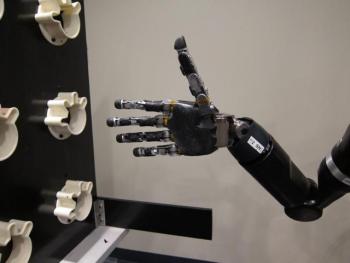
A woman with quadriplegia was able to demonstrate "10-degree brain control" in a robotic prosthetic arm.
Image credit: Journal of Neural Engineering/IOP Publishing
The findings from the latest experiment, which was conducted by researchers at the University of Pittsburgh School of Medicine in Pennsylvania, are published in the Journal of Neural Engineering.
The woman who took part in the study is 52-year-old Jan Scheuermann, who is quadriplegic and was diagnosed with a variant of spinocerebellar degeneration without cerebellar involvement.
In February 2012, the team surgically implanted small electrode grids with 96 tiny contact points each into the regions of Scheuermann's brain that - under normal circumstances - control her right arm and hand movement.
The electrodes were able to pick up signals from individual neurons, which then communicated with a computer that identified firing patterns associated with certain observed or imagined movements, including raising or lowering the arm.
Results from that initial study - in which Scheurmann was able to go so far as to flex the wrist of the prosthetic arm back and forth, move it from side to side, rotate it and grip objects - demonstrated "7D control." The findings were published in The Lancet in 2012.
But in this latest study, led by a research team at the Pitt School of Medicine, Scheurmann was able to master "10D control," which involved moving the robotic hand into different positions while controlling the wrist and arm.
'Findings show movement can be restored to people with paralysis'
The researchers explain that brain-machine interfaces (BMIs) "offer the possibility of bypassing the damaged tissue by decoding movement intention and controlling assistive devices" - such as computer cursors or robotic arms.
This project has shown that we can interpret signals from neurons with a simple computer algorithm to generate sophisticated, fluid movements that allow the user to interact with the environmen.
For their latest work, the team replaced the simple pincer grip on the prosthetic arm with four hand shapes: finger abduction, scoop, thumb opposition and a pinch of the thumb, index and middle fingers, bringing the total of arm and hand movements to 10.
During the experiment, Scheurmann watched animations of movements and imagined them, and the team recorded the signals her brain sent to calibrate the system. Next, they used that information to "read her thoughts," allowing her to move the hand into the desired positions.
Commenting on the results, the research team says:
"Jan used the robot arm to grasp more easily when objects had been displayed during the preceding calibration, which was interesting. Overall, our results indicate that highly coordinated, natural movement can be restored to people whose arms and hands are paralyzed."
Although their experiment was only conducted in one human, the researchers note that their results are comparable to previous studies of neural tuning and robotic arm BMI performance in primates.
"Interaction with physical objects is relatively new in the BMI field, though several studies have demonstrated this with some success, most of which operated in a lower dimensional space," they say.
In October of this year, Scheurmann concluded her involvement in the study by having surgery to remove the electrode arrays, but she describes it as "a fantastic, thrilling, wild ride," adding that the study "has enriched my life, given me new friends and coworkers, helped me contribute to research and taken my breath away."
References:
1. Ten-dimensional anthropomorphic arm control in a human brain−machine interface: difficulties, solutions, and limitations, AB Schwartz, et al., J Neural Eng, doi:10.1088/1741-2560/12/1/016011, published 16 December 2014.
2. University of Pittsburgh Schools of the Health Sciences news release, accessed 17 December 2014 via Eurekalert.
No comments:
Post a Comment